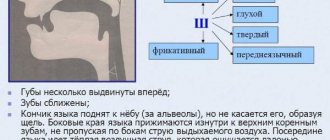OHP level 1
Level 1 speech underdevelopment in children is characterized by the presence of babbling speech with the active help of facial expressions and gestures. The lexical vocabulary is limited to onomatopoeias and syllables that sound similar to the words the child needs. The grammatical part of speech is not developed; even if phrases of several words are constructed, they are absolutely not consistent with each other. At the same time, auditory and visual attention and memory are impaired.
In correctional classes, the main emphasis is on expanding the child’s active and passive vocabulary, developing attention, improving fine motor skills and the functioning of the articulatory organs.
Games and exercises:
- To improve the perception of non-speech sounds, the game “What does it sound like?” is used. The child is invited to listen to various everyday sounds (the rustling of paper, the sound of pouring water), the sound of musical instruments or toys. Then, having heard familiar sounds, the child must show what kind of object makes them.
- The game of blind man's buff is also good for activating auditory attention. Blindfolded, children must catch the leader clapping his hands, focusing on the sound.
- To expand the lexical vocabulary, didactic games are played - “Who came?”, “Parts of the body”, “Fruits and vegetables”, etc. The toys are shown to the child and their names are pronounced clearly. After this, the children must name the objects themselves.
- “Clap like me!” - the teacher claps his hands several times at different tempos, the children must reproduce the rhythmic pattern.
- To develop fine motor skills, drawing, modeling, finger games, picking through cereals, and playing with sand are used.
- “Look Carefully” - coloring game. According to the instructions of the adult, the child must color only the necessary images in the picture (only fruits or vegetables or animals).
Causes
The characteristics of level 2 OHP indicate the polyetiological nature of the speech defect. That is, physical, biological and social prerequisites become the culprit for the development of the disorder. The main provoking factors are:
- fetal hypoxia;
- Rh conflict between mother and child;
- birth asphyxia;
- head injuries received at birth and in the first year of life;
- infections with neurotoxicosis;
- perinatal encephalopathy;
- pedagogical neglect;
- communication deficit;
- heredity
- separation from home, or hospitalism syndrome.
Often, OHP is a consequence of a complex of causes. This is important to consider when diagnosing and correcting a speech defect.
OHP level 2
Children with level 2 ODD use both words and babbling utterances in communication. The grammatical aspect of speech suffers seriously - there is no agreement between the noun and the verbs, words denoting the attribute or quality of an object are not used. Word formation skills are not available to the child.
In addition to working with the above problems, it is also necessary to carry out work on staging the pronunciation of sounds, as well as the development of phonemic analysis and synthesis.
Exercises:
- To improve phonemic awareness, games are offered to identify the desired phoneme. For example, the “Catch the Sound” exercise. The adult pronounces the word clearly and not very quickly, while the child must clap his hands or hit the table with his palm when he recognizes the desired sound.
- “Who made a mistake?” A similar game, but slightly changed. The teacher pronounces words, replacing a certain phoneme in them, and children must stomp or raise their hand when the word is pronounced correctly.
- The "Clap Your Hands" game gets a little more complicated. Now the claps will separate the syllables. We pronounce the word syllable by syllable, marking each of them with a clear clap.
- To develop the articulatory apparatus, children are required to do “Tongue exercises.” The tasks are offered from simple to complex and taking into account the individual needs of the child.
- "Who's the little one?" - a game to develop word formation skills. The teacher shows pictures of adult animals and their babies, clearly pronouncing their names. Intonation distinguishes the method of word formation. Now the child must say what is the name of the baby in the picture?
- Work is also being carried out to study word agreement. For example, using the game of finding a toy. The teacher hides an object, and the child must follow the instructions to find it (UNDER a chair, BEHIND a book, etc.).
- The development of coherent speech is carried out within the framework of discussion of game moments and fairy tales. The adult asks the children questions: who came to class? Where did the bun roll to?
- Games and exercises for the development of motor skills remain extremely relevant. Children are offered lacing, appliqué, shading and coloring. Finger games and exercises are included in every lesson.
Child according to the structure of speech impairment: OHP level 3
Age: 6 years
The date of the:
Lesson topic: sound R.
Goal: automation of the sound R in syllables, words, sentences.
Tasks:
- consolidate the correct pronunciation of the sound R in syllables, words and sentences
- strengthen the ability to coordinate numerals with nouns
- strengthen the ability to make sentences based on pictures.
Planned results of the lesson: correct pronunciation of the sound R in syllables, words and sentences.
Equipment: articulation gymnastics cards, game picture material, mirror, echophone, ball.
Progress of the lesson:
1. Organizational moment (2-3 min)
Speech therapist: - Hello (says the child’s name). (Hello).
Speech therapist: - Listen carefully to the poem that I will read.
Somehow early in the morning
A gloomy crayfish digs a hole.
Cancer would be glad not to dig it,
But you have to live somewhere.
Cancer is reluctant to work,
He is not happy with his work.
Speech therapist: - Tell me, please, what sound did I highlight in my voice? (Sound R). That's right, today we will practice pronouncing the sound R correctly.
2. Main part (18 min)
A. Articulation analysis.
Speech therapist: - Let's remember how we pronounce the sound R? What's happening to your lips? Are your lips stretched into a smile? Are your teeth visible? Yes. The mouth is slightly open. Where is the tongue located? Behind the upper teeth. The tongue is trembling.
b. Articulation gymnastics.
Speech therapist: - First, let’s prepare our tongue. Let's do the exercises in front of the mirror.
“Swing” - the tongue swings up and down.
“Horse” - the horse is galloping, its hooves are clattering.
“Painter” - and now let the tongue work as a painter and paint the sky-ceiling (stroke the hard palate with the tip of the tongue, making movements back and forth).
“Drummers” - imagine that your upper teeth are a drum, and your tongue is a drummer. Tap your tongue behind your upper teeth from the inside, clearly saying: D-D-D...
“Football” - a breeze has arrived, he wants to play football. This is the ball. Get the ball into the goal. (Stretch your lips with a tube and blow on the cotton wool, trying to drive the ball into the goal. The stream of air should be continuous and long).
V. Pronouncing an isolated sound.
— Shall we play wizards? One, two, turn into animals. Draw an angry tiger and show how menacingly it growls (Rrr). Picture a woodpecker sitting on a tree and how he knocks on the tree (Pur-r-r, tr-r-r.) Picture how an affectionate cat purrs (Pur-r-r-r.) Well done.
d. Automation of the sound P in isolation and in syllables.
Game "Catch the Sound"
Speech therapist: - Clap your hands when you hear the sound R.
a) at the level of a number of sounds: R R N G R Z R R R V R D R F M R R R
b) at the level of a number of syllables: RA-LO-PO-RU-WE-OR-VA-RA-RY-KO-RU-AR
c) at the word level: watermelon, window, kefir, mosquito, sky, backpack, loaf, rocket, robot, glass, mole, axe, house, fire.
Game "Echo"
Speech therapist: - Take the microphone. Listen carefully and repeat after me.
| RA-RA-RA RU-RU-RU | RO-RO-RO RY-RY-RY | AR - OR - AR OR - AR - OR |
| RA-RO-RU RO-RY-RA | RY-RU-RA RU-RA-RO | OR - IR - OR UR - AR - UR |
d. Physical education minute
Speech therapist: - I suggest you warm up a little.
Snow was falling on the threshold (slowly hands up and down)
The cat made himself a pie. (press our palms together - make a pie)
In the meantime, I sculpted and baked,
The pie flowed away like a stream. (fingers of both hands ran across the table)
Bake some pies for yourself (we press our palms together and make a pie)
Not from snow - from flour.
e. Automation of the sound [P] in words and phrases.
Game "Rhinoceros Postman"
Speech therapist: — The rhinoceros postman delivers letters, but we recognize who they are from from the picture.
Rhino delivers letters from...
Game "Stargazer"
Speech therapist: - Light up stars in the sky, naming the picture on the back.
Speech therapist: - Choose a star. Count the object in the picture to five.
and. Automation of the sound R in sentences.
Speech therapist: - Look at the pictures and answer the questions:
-What is the crow doing? (Crow assembles a pyramid)
-What does the trumpet player do? (The trumpeter blows the trumpet)
— What does the drummer do? (Drummer drums the drums)
- What is Pinocchio holding in his hands? (Pinocchio holds a notebook and pencil in his hands)
— What is Roma doing? (Roma jumps over the stream)
-What is Raya doing? (Raya holds a basket of fruit in her hands)
3. Lesson summary (2 min)
Speech therapist: - Well done, Lera! Well done. Tell me, what sound did we learn to pronounce correctly?
OHP level 3
In children with general underdevelopment of speech at level 3, the presence of phrasal speech is noted, but it appears to be a variant with very “lame” grammatical structure and pronunciation. The agreement of words in a sentence, changes in gender, number and cases suffer; some sounds, even those that sound correctly individually, are pronounced unclearly during coherent speech or are replaced by others.
At the same time, children have a fairly extensive vocabulary and can briefly talk about some event, using even complex sentences. However, there are impairments in all aspects of speech.
Speech therapy classes include exercises covering all aspects of speech - grammatical, phonemic and lexical.
Exercises and games:
- "Professions". To expand the vocabulary, the names of professions are studied. The game uses cards depicting people of one specialty or another - children must name them correctly. Another option is to match the card to a person of a certain profession with images of a form or tools that suit him. A prerequisite is to name all the concepts correctly.
- “Whose tail?” To master the norms of word formation, a game with cards is offered, in which you need to choose the right tail for an animal. And name it correctly! (Whose tail? - Fox, bear, etc.).
- “What is he like?” In this game, children expand their vocabulary and learn to use adjectives in speech. The teacher shows the object and asks what it is. (For example, a ball is round, bouncy, rubber).
- Another variation of this game is to search for an item based on its description. The child must find the one the teacher is talking about from the toys placed on the table.
- The game "It's the other way around" teaches children to use antonyms. The teacher throws the ball to the child and says the word (“long”), the child must say the word with the opposite meaning (“short”) and throw the ball back.
- You can also play “One and Many” with a ball. The teacher pronounces the word in the singular, the child must say the plural form.
- To develop coherent speech, stories based on pictures are used. Children enjoy looking for the correct order of pictures with various events, and then (first with the help of leading questions) they compose a short story.
- The concentration of auditory attention is developed by games such as “Come up with a word.” Children need to name a word that starts with a given sound. Subsequently, the task can be complicated - the sound can be at the end of the word or in the middle.
- “Assemble a pyramid” - we string the rings, slowly pronouncing the words. How many syllables, so many rings.
General speech underdevelopment can become a serious problem for the child and his parents. Therefore, it is very important to begin corrective measures as early as possible. An experienced speech therapist will help you cope with speech disorders, but this will take time. Timely consultation with a specialist will help avoid many difficulties.
Diagnostics
A comprehensive examination of a preschooler with speech disorders is carried out. Conclusions from a speech therapist, neurologist, and child psychiatrist will be required. The OHP diagnostic route consists of several stages:
- A conversation with parents to collect anamnesis and find out the possible cause of the speech defect.
- Assessing the level of development of a child’s speaking skills.
- Exclusion or confirmation of concomitant diseases, developmental delays.
- Studying the structure of the speech apparatus to detect organic disorders.
The final diagnosis is made based on the conclusion of the consultation. To send a child to a speech therapy kindergarten, it is necessary to undergo a PMPK. The commission must submit a reference for a preschooler from a preschool educational institution or from a psychologist. They will have a conversation with the child and parents and give recommendations on subsequent education. The program of individual work in accordance with the requirements of the Federal State Educational Standard will be drawn up by a teacher of the educational institution.
Treatment of OHP is a labor-intensive process. You cannot rely only on preschool teachers; be sure to do extra work at home, talk to your child more and listen to his statements.






